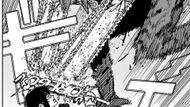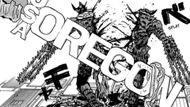Chainsaw Man keeps climbing into disastrous heights with Chapter 221, which happens to be the immediate consequences of Yoru unleashing havoc on Michigan and even more alarmingly, it is followed by more damage on a state scale. The most recent episode of the series increases the stakes beyond the collapse of a single state to a chain of regional destruction; the range of combat is now extended not over a personal fight, but over the geopolitical disaster. The new chapter has exposed the reader to the transformation of whole states of the U.S. into war equipment. Such developments have brought about a lot of critical debate concerning the issues of scale, theme and authorial intent in Chainsaw Man.
Chapter 221 of Chainsaw Man portrays Yoru creating additional state-sized armaments, that is, the chapter affirms the creation of a blade that is related to Oregon and also reflects the possibility of mass sacrifices, which are related to Virginia, after the previous collapse of Michigan. Chapter pages and immediate critical coverage mark Oregon as the following named state that Yoru weaponizes, and several recaps mention Virginia as one of the areas that were destroyed in her attack. The framing of the story allows one to understand that it is not metaphorical hyperbole but in-story destruction.

Chapter 221 can be found on Shueisha and Viz Media licensed platforms, and the official panels reflect the powers Yoru had as having evolved into a multi-state event rather than an ominous one-calamity event. The first pages of the chapter begin with instances of physical congestion of space into edged tools, then continue to combat pages where the newly named Oregon blade is in action. These lines are delivered by the usual display of Fujimoto, in the combination of brutal visual economies and shock, and are read as the intentional narrative overstatement, not as the unintentional extravagance.
Critical reactions published a few hours after the release commented upon the extent of the devastation in Chapter 221 as going up to the constraints of the inner logic and thematic register of the series. Critics noted that transforming states into weapons alters the traditional perspective of Yoru as a fighter to one who rearranges the space of geography and civilian life on a large scale. The visual captions used in the chapter, which were used to document the time of the collapse of Michigan, are now spread to Oregon and mention the prevalence of sacrifice elsewhere, furthering the feeling of universal fear.

Combined, these aspects create a significant shift in Chapter 221 of Chainsaw Man. The War Devil tactics now cover not just the mastery of the battlefield but, quite literally, turn political units into weapons. The in-story impact is two-fold: Pochita/Denji and Yoru intensify their conflict, and the cost in human lives becomes disastrous. The readers are encouraged to take the decision made by Fujimoto both as a plot and as a statement of the theme of war, agency and eradication of civil order.
Chainsaw Man: what Chapter 221 shows and why it matters
Chapter 221 of Chainsaw Man is iconographically inclined: topography and urban detail are pressed into blade-like negative space in the panels, and times and places are captured in caption boxes in a documentary manner. The output in Chainsaw Man is a look that transforms reportage into a weapon of horror; the clinical details of the text enhance the emotional effect by objectifying the mass slaughter as an item. To those readers who read the series in official form, the chapter is a vivid illustration of the way Fujimoto combines minimalism in prose with maximalism in implication.
The Oregon blade and the sacrifices reported in Virginia make an easy reading of the fight as a personal problem. The fact that Yoru is able to weaponize entire states repositions her as a strategic player at the geopolitical level. Such a change compels other characters to react not only through individual strategies but through factors of mass defense, evacuation, and the morality of civilian losses in comparison to military goals. It also broadens the ethical issues that the manga has raised over the course of its series.

These events are practically confirmed by reading the official English releases of Viz and the original publication of MangaPlus, which also carries Chapter 221. The main evidence of the claim that Oregon is actively weaponised in the chapter and that other states, such as Virginia, experience mass casualties during the sequence, is given in the official pages. Due to the brevity and compactness of the chapter, a straightforward reading is the surest method of evaluation of scope, sequence and authorial emphasis.
Finally, Chapter 221 of Chainsaw Man takes the destruction of Yoru out of Michigan and into an explicitly named blade of Oregon and acts of widespread sacrifice in places like Virginia, which dramatically expands the scope of the conflict. Such canonical formations transform one battalion confrontation into an incident with national, and potentially, international implications. To the reader and analysts, the chapter summarises a new stage of the narrative of Fujimoto: a war where geography itself turns into a weapon and a victim.
